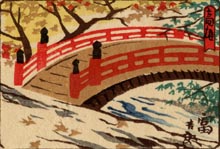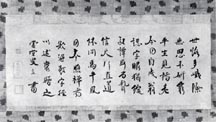| |
|

The popularity of tea is worldwide, but nowhere in the world does
tea contribute as much to the cultural milieu as in Japan. There
the preparation and drinking of tea has acquired esthetic significance
and has developed into a distinct artistic accomplishment. The
following brief history outlines the events that resulted in this
simple yet deep cultural practice.
The Beginning of
Tea
One of the earliest treatises on tea drinking dates from eigthth
century, The Classic of Tea written by Lu Yu (d.786). The influence
of this book may be seen in the subsequent Tang (818-907) and
Sung (960-1279) Dynasties where a flourishing culture included
the widespread drinking of tea. Japanese scholar-priests, such
as Saicho (727-822) and Kukai (774-835) who had travelled to China
on cultural missions, most likely brought the first tea seeds
and tea drinking practices back to Japan.
The first record of tea drinking in Japan occurred in 815 when
the Emperor Saga received tea at Sufukuji Temple while on a journey.
A few poetic anthologies from the same age also mention the drinking
of tea. The Tang period method of tea preparation is what is known
as brick tea these days. The leaves are steamed, formed into a
hard, dried shape, and then shaved into boiling water with seasonings.
The method appears not to have agreed with Japanese taste because
no further records refer to tea for about two hundred years.
 Tea
in the Kamakura Period (1185-1392) Tea
in the Kamakura Period (1185-1392)
Tea seeds were reintroduced to Japan by another returning
scholar-priest Eisai (1141-1215), along with the teachings
of Rinzai Zen. He wrote a treatise named Kissa Yojoki,
praising tea for fostering both physical and spiritual
health, and thus tea drinking again was embraced by Buddhist
priests as well as by their wealthy patrons. The seeds,
planted first in Kyushu and then in the mountainous Togano-o
region west of Kyoto, eventually produced tea plants
that were cultivated throughout the central provinces.
Tea from Togano-o retained a reputation for flavor and
quality indicated by its designation honcha, that is “original
tea,” or “real tea.” The Sung Dynasty
method of tea preparation that Eisai brought to Japan
involved the powdered green tea that we know today. While
the precise gestures used to make the tea are not known,
the utensils are; a kettle and brazier, a Temmoku teabowl
on a lacquered stand, a bamboo whisk. In Japan drinking
powdered green tea was practiced largely in Zen temples
where, in addition to its acclaimed medicinal properties,
the manner in which tea sharpened mental and physical
acuity assisted the monks in their long hours of study
and meditation.


Tea
in the Nambokucho
(1336-1392) and Muromachi (1392-1568) Periods
As menioned earlier, tea drinking also occurred in the secular
reception rooms of the temples’ powerful patrons. At first
these gatherings were occasions to experience and appreciate
Chinese culture, in which tea drinking played a role similar
to that in Zen temples. Later, however, as the political and
economic stability of the country deteriorated, tea drinking
was taken as the basis for a luxurious amusement.
Tea tasting contests challenged participants’ ability to distinguish
Togano-o “original tea” from other varities (hicha or “non-tea”),
and were accompanied by rampant gambling, feasting, and drinking of wine and
tea. However the political and economic situation worsened and Japan entered
the period known as the Hundred Years of Civil War (Sengoku Jidai, 1482-1558),
this type of frenetic recreation faded away.
A more contemplative removal from the chaotic world gained favor, typified
by gatherings hosted by the eighth Ashikaga shogun, Yoshimasa (1436-1490).
Within a small, four-and-one-half mat room on his Ginkakukji estate, Yoshimasa
sought for consolation, and perhaps illumination, through the arts. He gathered
around him the foremost men of culture of the time, renowned among them Noami
(1397-1471), his son Geiami (1431-1485), and grandson Soami (d. 1525). Noami
is said to have conducted elegant tea gatherings for Yoshimasa, utilizing the
extensive Ashikaga collection of works of Chinese art, and to have introduced
Yoshimasa to the innovative teamaster, Murata Shuko.

Shuko’s Tea
Murata Shuko (1423-1502) entered a temple in Nara at a young age but left temple
life for reasons not fully understood. At some point he met the iconoclastic
priest Ikkyu (1394 - 1481) from Daitokuji temple under whom he is thought to
have studied. Ikkyu encouraged Shuko to consider that the same spirit prevails
in both Zen training and the mastery of Tea. Thereafter Shuko applied himself
to this principle. He is the first to have included in the responsibilities
of the host the physical act of making tea for the guests.
Two written documents are associated with Murata Shuko. First
is the “Dialogue with Shuko (Shuko Mondo),” reportedly
a conversation on tea practice between Yoshimasa and Shuko.
 In
it Shuko says that upon entering the tearoom, all discrimination
betwen self and other vanishes, a spirit of gentleness prevails,
and that peace may be attained when modesty, respect, purity
and tranquility are understood. In
it Shuko says that upon entering the tearoom, all discrimination
betwen self and other vanishes, a spirit of gentleness prevails,
and that peace may be attained when modesty, respect, purity
and tranquility are understood.
Second is Shuko’s “Letter on the Heart (Kokoro no fumi).” In
this document, Shuko emphasizes the practice of tea as working towards a knowledge
of the self and advocates an equality between Chinese and Japanese culture.
Both concepts are closely bound to the aesthetic hiesabi, or chill and aged,
as an expression of the heart of Tea. Shuko’s style of tea is known as “thatched
hut tea (soan cha),” for its simplicity and directness. Here is the advent
of tea practice that can be more than entertainment, medicine, or temple sacrament;
that preparing and sharing a bowl of tea parallels the Zen notion that, “every
act of daily life is a potential act that could lead to enlightment.”

Takeno
Joo’s Tea
War continued to rage thoughout the country, although the city
of Saki maintained a position of relative peace and safety. Shuko’s
tea practice, which appealed greatly to the commoner class from
which he hailed, flourished in this city of merchants. The name
of one man in particular, Takeno Joo (1502-1555), remains as inheritor
of Shuko’s tea, though study with Shuko’s pupils Sochin
and Sogo.
Before coming to tea practice, Joo studied linked verse (renga)
and the way of incense (kodo), traditions handed down within court
culture. He combined the values from courtly traditions with Shuko’s
interpolation of warrior and Zen traditions, which had informed
tea practice, to move “thatched hut tea” one step
further, to the aesthetic known as wabi.
Joo’s contributions to the Way of Tea are outlined in his
“Letter on Wabi (Wabi no fumi).” Here he states, “Wabi
is honesty, prudence and self-restraint, both emotional and material.”
Befitting a linked verse poet, Joo illustrated his notion of wabi
by quoting a poem by Fujiwara Teika: “Neither blossoms nor
tinted foliage are seen around a rush-thatched hut that stands
alone by the sea strand, twilight of autumn.”

Sen Rikyu and The Way of Tea
Tea practice became de rigeur for Sakai merchants. Among them
was an exceptional young man later known as Sen Rikyu (1522-1591).
Initially he studied the elegant tea traditions of the ruling
warrior class under Kitamuki Dochin (1504-1562). At age nineteen
he began to study with Takeno Joo. Once again traditions and interpolations
collided.
The greatest influence on Rikyu’s tea was
his study of Zen, leading to an emphasis on the immediate and
on non-duality. One of his pupils likened Rikyu’s tea practice
to a tree in winter, and said he made mountains into valleys and
low into high. Rikyu himself turned, like his teacher Joo, to
poetry to describe his views on wabi, “To those who long
only for flowers in full bloom, I would show the spring of young
shoots pushing through snow in a mountain village” [by Fujiwara
Ietaka].
Among the best known of Rikyu’s innovations
in tea are the “crawling in” entrance to the tearoom,
which eliminates distinctions of rank or class among those who
enter, the use of barely modified natural objects like bamboo
and gourd vases, and the liminal beauty of Raku teabowls.
Rikyu served as one of the “three under heaven”
tea masters to the military rulers Oda Nobunaga (1534-1582) and
Toyotomi Hideyoshi (1536-1598), a position of great renowned and
prestige but not without peril. At age seventy, Rikyu incurred
the displeasure of Hideyoshi and was ordered to end his life.

Tea
After Rikyu (1615-1868)
Rikyu’s pupils ranged from daimyo lords to town merchants.
However in the succeeding age, the overwhelming impression of
tea practice is of daimyo tea. Furuta Oribe (1544-1645), one of
Rikyu’s pupils, and Kobori Enshu (1579-1647), a pupil of
Oribe, did much to shape daimyo tea, establishing more mannered
expressions of creativity and returning to a sense of priviledge
and ornamentation that had characterized tea drinking in the time
of the Ashikaga shogunate.
This did not mean that wabi tea disappeared. The
tea practice pioneered and refined by Shuko, Joo, and Rikyu lives
on in this esthetic which is embraced by all those whose hearts
incline towards tea, whether or not they actively study. In particular
Rikyu’s practice of tea flourishes in the dedication of
his descendants to the Way of Tea. The Urasenke Tradition of Chanoyu,
headed by Zabosai Genmoku Soshitsu, sixteenth generation descendant
of Sen Rikyu, is among the largest and most active of present
day traditions.

|
|
 |
 |